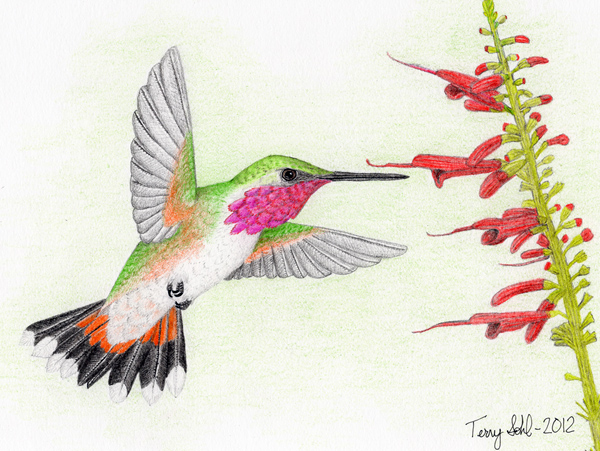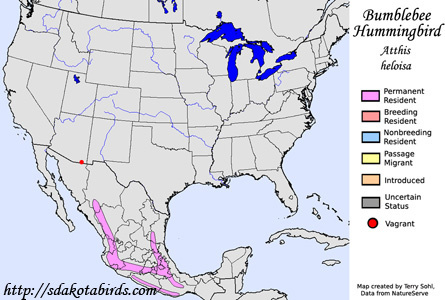Bumblebee Hummingbird
Atthis heloisa
| Length: 2.75 inches | Wingspan: 4 inches | Seasonality: Non-resident in South Dakota |
| ID Keys: Tiny size, magenta gorget on male, bright green upperparts, whitish underparts | ||
 The
Bumblebee Hummingbird is one of the smallest birds in the world, at only 2
3/4" in length, and lighter in weight than a U.S. penny. The Cuban Bee
Hummingbird is the only bird considered to be smaller than the Bumblebee
Hummingbird, but even these two species are very close in size. Given
the small size and a bumblebee-like flight pattern, the species can often
forage relatively unnoticed among other hummingbird species, protecting it
from territorial aggressiveness that hummingbirds often display.
The
Bumblebee Hummingbird is one of the smallest birds in the world, at only 2
3/4" in length, and lighter in weight than a U.S. penny. The Cuban Bee
Hummingbird is the only bird considered to be smaller than the Bumblebee
Hummingbird, but even these two species are very close in size. Given
the small size and a bumblebee-like flight pattern, the species can often
forage relatively unnoticed among other hummingbird species, protecting it
from territorial aggressiveness that hummingbirds often display.
Habitat: Found in montane forests of pine and oak in Mexico.
Diet: Typical diet of hummingbirds, primarily nectar, but insects also comprise a portion of the diet.
Behavior: Typically much less aggressive than other hummingbird species, given its small size. They will often utilize territories established by other hummingbird species, remaining as unobtrusive as possible. Where competition with other hummingbird species is less intense, Bumblebee Hummingbirds will establish feeding territories and defend them from other Bumblebee Hummingbirds, as well as large insect intruders.
Nesting: Males form loose groups at the start of the breeding season, with females visiting courting groups while males compete for the female's attention. Females alone build the nest, incubate the eggs, and take care of the young. The nest is a tiny cup made of plant fibers, with spider webbing used to help construct the nest. The outside of the nest is typically covered with moss..
Song: The call is a high "chip". The groups of males attempting to attract females will sing a variety of high thin warbles, or other short songs.
Migration: Bumblebee Hummingbirds are permanent residents throughout their range.
Interactive eBird Map: Click to access an interactive eBird map of Bumblebee Hummingbird sightings
Feeders: Will attend hummingbird feeders
Similar Species: Possibly confused with Lucifer Hummingbird, which has similar gorget style.
Conservation Status: No conservation concerns are presently noted for the species.
Further Information: 1) Cornell's Neotropical Birds - Bumblebee Hummingbird
2) AvianWeb.com - Bumblebee Hummingbird
Image Information: Color pencil drawing of a Bumblebee Hummingbird - Terry Sohl - February 2012.
| Click below for a higher-resolution map |
 |
| South Dakota Status: Non-resident in South Dakota |
Additional Bumblebee Hummingbird Images
Click for a higher-resolution version of these photos

